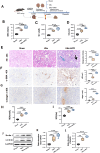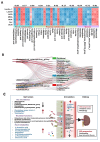Alterations in the gut microbiome and metabolism profiles reveal the possible molecular mechanism of renal injury induced by hyperuricemia in a mouse model of renal insufficiency
- PMID: 39132829
- PMCID: PMC11321104
- DOI: 10.1080/0886022X.2024.2387429
Alterations in the gut microbiome and metabolism profiles reveal the possible molecular mechanism of renal injury induced by hyperuricemia in a mouse model of renal insufficiency
Abstract
Objectives: To investigate the role of the intestinal flora and metabolites in the development of hyperuricemic renal injury in chronic kidney disease (CKD).Methods: Unilaterally nephrectomized mice were fed with adenine and potassium oxonate for 9 weeks. HE staining combined with plasma biochemical indicators was used to evaluate renal pathological and functional changes. We conducted 16S rRNA sequencing and untargeted metabolomics on feces and plasma samples to reveale changes in intestinal microbiota and metabolites.Result: Our analysis revealed significant differences in 15 bacterial genera, with 7 being upregulated and 8 being downregulated. Furthermore, metabolomic analysis revealed changes in the distribution of amino acid and biotin metabolites in basic metabolic pathways in both feces and serum. Specifically, differentially abundant metabolites in feces were associated primarily with histidine metabolism; the biosynthesis of phenylalanine, tyrosine, and tryptophan; and tyrosine metabolism. In plasma, the differentially abundant metabolites were involved in multiple metabolic pathways, including aminoacyl-tRNA biosynthesis; glycine, serine, and threonine amino acid metabolism; valine, leucine, and isoleucine biosynthesis; tyrosine biosynthesis and metabolism; biotin metabolism; and taurine and hypotaurine metabolism. Furthermore, correlation analysis revealed that Akkermansia, UCG-005, Lachnospiraceae_NK4A136_group, Lactococcus, and Butymonas were associated with various differentially abundant metabolites as well as renal function, oxidative stress, and mitophagy. The changes in the intestinal flora observed in hyperuricemia may lead to imbalances in amino acid and biotin metabolism in both the intestine and host, ultimately affecting oxidative stress and mitophagy in mice and accelerating the progression of CKD.Conclusion: Our findings provide insights into a potential pathogenic mechanism by which hyperuricemia exacerbates renal injury in mice with renal insufficiency. Understanding these pathways may offer new therapeutic strategies for managing hyperuricemic renal injury in CKD patients.
Keywords: Chronic kidney disease; gut microbiota; hyperuricemia; metabolism profiling; renal injury.
Conflict of interest statement
Upon manuscript submission, all the authors completed the author disclosure form. The authors declare that they have no competing interests.
Figures






Similar articles
-
Compound probiotics alleviate hyperuricemia-induced renal injury via restoring gut microbiota and metabolism.BMC Microbiol. 2025 May 8;25(1):280. doi: 10.1186/s12866-025-04012-5. BMC Microbiol. 2025. PMID: 40335932 Free PMC article.
-
Leech Poecilobdella manillensis protein extract ameliorated hyperuricemia by restoring gut microbiota dysregulation and affecting serum metabolites.World J Gastroenterol. 2024 Aug 7;30(29):3488-3510. doi: 10.3748/wjg.v30.i29.3488. World J Gastroenterol. 2024. PMID: 39156502 Free PMC article.
-
Fecal metabonomics combined with 16S rRNA gene sequencing to analyze the changes of gut microbiota in rats with kidney-yang deficiency syndrome and the intervention effect of You-gui pill.J Ethnopharmacol. 2019 Nov 15;244:112139. doi: 10.1016/j.jep.2019.112139. Epub 2019 Aug 8. J Ethnopharmacol. 2019. PMID: 31401318
-
The gut microbiome, chronic kidney disease, and sarcopenia.Cell Commun Signal. 2024 Nov 21;22(1):558. doi: 10.1186/s12964-024-01922-1. Cell Commun Signal. 2024. PMID: 39574190 Free PMC article. Review.
-
Research progress on the mechanism of hyperuricemic nephropathy based on multi-omics technique: A review.Medicine (Baltimore). 2024 Dec 20;103(51):e40975. doi: 10.1097/MD.0000000000040975. Medicine (Baltimore). 2024. PMID: 39705438 Free PMC article. Review.
Cited by
-
The metabolome of fecal extracellular vesicles in patients with malignant solid tumors.Sci Rep. 2025 Aug 11;15(1):29402. doi: 10.1038/s41598-025-14250-2. Sci Rep. 2025. PMID: 40789885 Free PMC article.
-
Association between dietary index for gut microbiota and chronic kidney disease: A cross-sectional study from U.S. population.Prev Med Rep. 2025 Apr 8;53:103060. doi: 10.1016/j.pmedr.2025.103060. eCollection 2025 May. Prev Med Rep. 2025. PMID: 40264750 Free PMC article.
-
Interplay between gut microbiota and acute kidney injury: a review of their mutual influence and causation.Ren Fail. 2025 Dec;47(1):2522976. doi: 10.1080/0886022X.2025.2522976. Epub 2025 Jul 1. Ren Fail. 2025. PMID: 40592825 Free PMC article. Review.
-
Gut microbiota regulates oxidative stress and inflammation: a double-edged sword in renal fibrosis.Cell Mol Life Sci. 2024 Dec 5;81(1):480. doi: 10.1007/s00018-024-05532-5. Cell Mol Life Sci. 2024. PMID: 39636415 Free PMC article. Review.
-
A cross-sectional study: Relationship between serum oxidative stress levels and arteriovenous fistula maturation in maintenance dialysis patients.Open Med (Wars). 2025 Mar 17;20(1):20251149. doi: 10.1515/med-2025-1149. eCollection 2025. Open Med (Wars). 2025. PMID: 40109330 Free PMC article.
References
-
- Choe J, Park KY, Kim SK.. Oxidative stress by monosodium urate crystals promotes renal cell apoptosis through mitochondrial caspase-dependent pathway in human embryonic kidney 293 cells: mechanism for urate-induced nephropathy. Apoptosis. 2014;20(1):38–49. doi: 10.1007/s10495-014-1057-1. - DOI - PubMed
MeSH terms
Substances
LinkOut - more resources
Full Text Sources
Other Literature Sources
